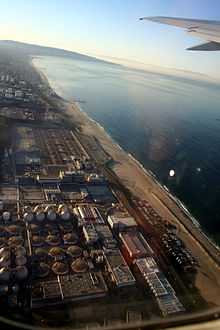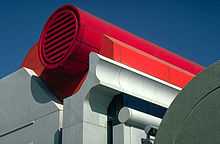Hyperion sewage treatment plant


The Hyperion Treatment Plant is located in southwest Los Angeles, California, next to Dockweiler State Beach on Santa Monica Bay. The largest sewage treatment facility in the Los Angeles Metropolitan Area, Hyperion is operated by the City of Los Angeles, Department of Public Works, Bureau of Sanitation.
History
Until 1925, raw sewage from the city of Los Angeles was discharged untreated directly into Santa Monica Bay in the region of today’s Hyperion Treatment Plant.[1]
With the population increase, the amount of sewage became a major problem to the beaches, so in 1925 the city of Los Angeles built a simple screening plant in the 200 acres (0.81 km2) the city had acquired in 1892.[1]
Even with the screening plant, the quality of the water in the Santa Monica Bay was unacceptable, and in 1950 the city of Los Angeles opened the Hyperion Treatment Plant with full secondary treatment processes. In addition, the new plant included capture of biogas from anaerobic digesters to produce heat dried fertilizer.[1]
In order to keep up with the increase of influent wastewater produced by the ever growing city of Los Angeles, by 1957 the plant engineers had cut back treatment levels and increased the discharge of a blend of primary and secondary effluent through a five-mile (8 km) pipe into the ocean. They also opted to halt the production of fertilizers and started discharging digested sludge into the Santa Monica Bay through a seven-mile (11 km) pipe.[1]
Marine life in Santa Monica Bay suffered from the continuous discharge of 25 million pounds of wastewater solids (sludge) per month. Samples of the ocean floor where sludge had been discharged for 30 years demonstrated that the only living creatures were worms and a hardy species of clam. Additionally, coastal monitoring revealed that bay waters often did not meet quality standards as the result of Hyperion’s effluent. These issues resulted in the City entering into a consent decree with the United States Environmental Protection Agency and the State of California to build major facility upgrades at Hyperion. In 1980, Los Angeles launched a massive sludge-out to full secondary program to capture all biosolids and keep them from entering the Bay. The sludge-out portion of the program was completed in 1987.
The $1.6 billion sludge-out to full secondary construction program replaced nearly every 1950-vintage wastewater processing system at Hyperion while the plant continuously treated 350 mgd and met all NPDES permit requirements.
West Basin Municipal Water District purchases approximately 37,600 AF, or roughly 9 percent of Hyperion’s secondary effluent for treatment at the Edward C. Little Water Recycling Facility.
In popular culture
A key scene in the 1973 film Soylent Green was shot at the Hyperion Treatment Plant. It portrayed the factory that cleverly produced the bland yet nutritious "Soylent Green" wafers.
Several key scenes from the 1956 science fiction film Earth vs. the Flying Saucers were shot at the Hyperion Treatment Plant. The plant is used to portray a science laboratory where the characters of the film develop a weapon to use against the unidentified flying objects that have invaded the Earth.
The same area of the plant was also used as the set for several scenes in the film Angry Video Game Nerd: The Movie.
External links
- Hyperion Treatment Plant Official Site
- West Basin Municipal Water District Urban Water Management Plan (2010)
- American Public Works Association Names Hyperion full secondary to its "Top Ten Public Works Projects of the Century"
- Google Maps Link Coordinates: 33°55′31″N 118°25′47″W / 33.9254°N 118.4298°W
Notes
References
Horenstein, B., Hernandez, G., Rasberry, G., Crosse, J. (1990) “Successful dewatering experience at Hyperion wastewater treatment plant”, Water Science and Technology, v. 22, p. 183-191
Jones-Lepp, T. and Stevens, R. (2007) “Pharmaceuticals and personal care products in biosolids/sewage sludge: the interface between analytical chemistry and regulation”, Analytical & Bioanalytical Chemistry, v. 387, p. 1173–1183